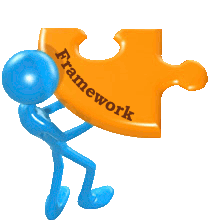‘Manual for professionals’
The ‘manual for professionals’ guides the users through the ‘organisational tool’ and also pinpoints different articles, checklists and questionnaires of the theoretical framework section.
The ‘manual for professionals’ addresses managers who are experienced in HR and skills development, trainers, training institutions and people working in the field of vocational training, i.e. people for whom skills development is not a completely new field of activity.
‘Organisational tool’

The idea behind the ‘organisational tool’ is the provision of a more holistic view on the vocational training situation in an enterprise. Questions related to the four following subjects are asked:
- Enterprise strategy & training (Strategy towards provision of training and competencies development),
- Training & incentive systems (Provision of incentives to encourage performance and skills improvement),
- Learning & workplace (Activities conducive to learning at the workplace) and
- Collaboration / information processes & competencies (Collaboration and flow of information within the organisation). This tool intends to raise questions and to support critical thinking concerning the provision of incentives towards vocational training. The ‘organisational tool’ includes an interpretation and a recommendation section as well as some background and further reading material.
Procedure
- Filling in the questionnaire
Most questions in this questionnaire reflect your personal opinions. Thus, there are no right or wrong answers. It is important to answer openly and honestly. The questions are formulated in such a way as to be answered with a simple tick, but only one tick per question!
Read every question carefully but proceed promptly with the assessment. Your first impression is usually the right one.
For each statement you will have to distinguish between five values ranging from “I strongly agree” to “I strongly disagree”.
If possible, do not leave out any question unless you have no opinion at all about it.
Completion should take about 20 minutes.
After having finished the questionnaire you have the possibility to
- save your answers in a file (to use in another session)
- proceed to the evaluation & results page
2. Documentation of results
After the questionnaire you are guided to the results section where graphical interpretations will help you to understand better the results.
In the “click for details” window (on the right hand side of the results page) you will be guided to a graphical representation of the questions you have answered before.
3. Recommendations
In a next step you can also obtain some background information and recommendations for those questions or groups of questions where the system has detected some starting points for further improvement (further training measures and improvements in personnel and organisational development).
The further recommendations link guides you to more background and additional information providing recommendations for further reading.
4. Next steps
With the print function on the results page you can print the results.
If you want to improve your organisation training situation you might also consult a training organisation for defining accordant training measures. The assessment results might be used as basis for your talks with a trainer or training organisation.
Theoretical framework

This section contains mainly articles and checklists about skills development in general and the assessment of training needs; it is divided into four chapters:
1. Basic remarks
This chapter includes some basic material about the investigation of training needs and guidelines how to address these needs with appropriate measures.
2. Vocational training
This section contains various documents (tools and background information) on vocational training. The user can learn about different self-training methods which can be used by the employees, get an overview about working conditions conducive to learning or learn about methods that can assist the analysis of a company’s training needs.
3. Corporate strategy
This section contains articles about the determination of further training needs (based on the corporate strategy) complemented by a series of checklists with essential questions on strategy development in connection with personnel planning.
4. Employee skills assessment
This chapter describes different instruments and contains checklists that can be used for your collaborators’ skills assessment.
|
